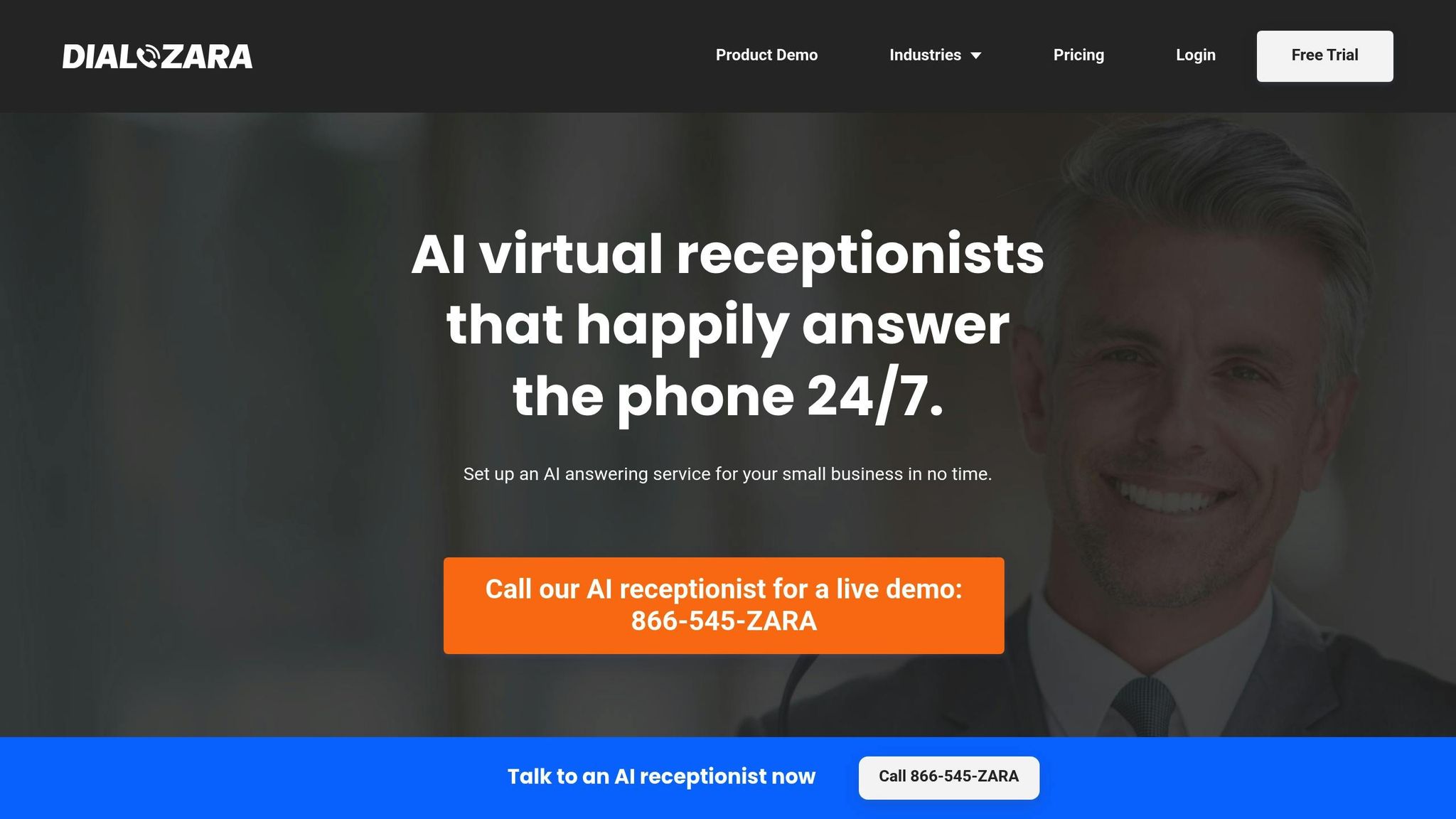AI Call Routing: How It Works

AI call routing uses artificial intelligence to direct phone calls to the right person or department quickly and efficiently. Unlike traditional menu-based systems, it analyzes speech, customer data, and real-time factors to make smarter routing decisions. Here's what you need to know:
-
Key Features:
- Recognizes natural speech using NLP (Natural Language Processing).
- Matches callers with the best-suited agent based on expertise, availability, and urgency.
- Works 24/7, reducing wait times and improving customer satisfaction.
-
Benefits for Small Businesses:
- Cuts costs by automating call handling, reducing the need for large teams.
- Improves customer service with faster resolutions and personalized experiences.
- Scales easily as your business grows.
- Example Results: Businesses using tools like Dialzara report up to a 60% drop in wait times, 25% higher customer satisfaction, and significant revenue growth.
Quick Comparison: AI Routing vs. Traditional IVR
| Feature | Traditional IVR | AI Routing |
|---|---|---|
| Language Understanding | Limited menu options | Natural, conversational flow |
| Adaptation | Fixed menus | Learns and improves over time |
| Personalization | Generic experience | Customized to caller history |
| Resolution Speed | Multiple transfers common | Direct connection to the right resource |
| Data Utilization | Basic input processing | Real-time, detailed insights |
AI call routing is a game-changer for small businesses, offering smarter, faster, and more cost-effective ways to handle customer calls. It’s ideal for businesses looking to improve efficiency without compromising service quality.
How AI Routes Phone Calls
AI call routing uses a mix of advanced technologies to manage incoming calls effectively. This system is especially helpful for small businesses looking to make the most of their resources.
Key Technologies
AI call routing relies on real-time data processing to understand the context of each call and predictive analytics to anticipate needs. It integrates:
- Speech recognition
- Current call center conditions
- Agent availability and expertise
Step-by-Step Call Process
When a call comes in, the AI system follows these three main steps:
- Call Identification: Automatically detects the caller ID and retrieves any existing customer records.
- Analysis Phase: Processes multiple data points at once, such as speech inputs and current call volume, to determine the call's purpose and urgency.
- Decision Making: Matches the call with the best-suited agent by considering expertise, workload, business rules, and historical data.
IVR vs. AI Routing
| Feature | Traditional IVR | AI Routing |
|---|---|---|
| Language Understanding | Limited menu options | Natural, conversational flow |
| Adaptation | Fixed menus | Learns and improves over time |
| Personalization | Generic experience | Customized to caller history |
| Resolution Speed | Multiple transfers common | Direct connection to the right resource |
| Data Utilization | Basic input processing | Real-time, detailed insights |
For example, a 5-agent HVAC company implemented AI call routing and saw a 40% drop in average hold times while maintaining a 98% customer satisfaction rate. This level of automation not only improves service but also reduces staffing challenges tied to manual call handling.
Small Business Advantages
AI call routing offers small businesses practical solutions to communication challenges, delivering three key benefits:
Cutting Costs
By automating call management, AI reduces expenses and boosts efficiency. Here's how:
- Lower Training Costs: AI manages routine calls, cutting down the need for extensive staff training.
- Easily Scalable: Handle more calls without a matching rise in costs.
- Fewer Mistakes: Accurate routing reduces misdirected calls, saving time and money.
These improvements lead to faster response times, making for happier customers.
Improved Customer Service
Data from Dialzara highlights the impact: a 60% drop in average wait times and a 25% boost in customer satisfaction.
| Service Metric | Before AI | After AI |
|---|---|---|
| Wait Times | 8+ minutes | 2-3 minutes |
| First-Call Resolution | 65% | 85% |
| Customer Satisfaction | 70% | 95% |
| Availability | 40-50 hours/week | 168 hours/week |
Dialzara Features

Platforms like Dialzara enhance these benefits by offering:
- Natural-sounding voice interactions.
- Automated call screening with precise routing.
- Understanding of industry-specific terms.
- Streamlined client intake processes.
- Smooth integration with CRM systems.
Setting Up AI Call Routing
Getting started with AI call routing requires a thoughtful approach to ensure everything runs smoothly.
Setup Steps
- Create a Business Profile: Add your business hours, services, and priorities using Dialzara's onboarding tools.
- Integrate Tools: Link your CRM and other essential apps for seamless operation.
- Configure Voice: Choose a voice and phone number that align with your brand.
- Design Rules: Set up routing rules based on customer intents and team expertise.
With these steps in place, you're ready to focus on improving the system.
Making It Work Better
To keep your AI call routing effective, focus on ongoing improvements. Here are some key areas to watch:
| Area to Improve | What to Do | Benefits |
|---|---|---|
| Data Analysis | Track call resolution times and transfer rates | Quicker issue resolution |
| Customer Feedback | Use post-call surveys to gather input | Better overall experience |
| System Updates | Regularly update AI with recent data | Fewer misrouted calls |
Common Mistakes to Avoid
Avoid these common pitfalls when implementing AI call routing:
- Overcomplicated Rules: Keep workflows simple. Complex decision trees can frustrate customers and lead to system errors.
- Poor Integration: Ensure your CRM connects seamlessly. For instance, an insurance provider using Dialzara cut their average handle time by 42% after fully integrating their CRM.
- Insufficient Testing: Test all possible call scenarios thoroughly before going live. Limited testing can miss critical issues.
- Neglecting Updates: Schedule regular reviews - monthly is a good rule of thumb - to keep your AI's knowledge base up-to-date with product and service changes.
sbb-itb-ef0082b
Business Examples
When businesses set up the system effectively, they see clear improvements across various industries:
Industry Examples
- Healthcare: Automatically routes calls based on symptom urgency and schedules appointments without manual intervention.
- Legal: Uses voice analysis to connect clients with attorneys specializing in their specific needs.
Dialzara Results
The impact of Dialzara's setup is evident in real-world examples. For instance, HomeQuest, a real estate agency, saw a 28% boost in lead conversion rates. They also cut their average call handling time from 4.5 minutes to 2.8 minutes, resulting in a $150,000 revenue increase. This success was made possible by Dialzara's 24/7 availability and smart call screening.
Insurance agencies also benefit significantly. By implementing Dialzara's automated intake workflows, they cut routine inquiry times in half and increased after-hours leads by 30%.
These examples highlight how Dialzara's round-the-clock service and intelligent routing allow businesses to seize new opportunities without compromising service quality.
Summary
AI call routing is changing the game for small businesses, offering advanced tools to improve customer communication - tools that were once only accessible to large companies. It tackles common small business challenges by streamlining operations and saving time.
Key Advantages
Here are some standout perks of AI-driven call routing:
- 24/7 call handling: Never miss a call, even after hours.
- Quick expert connections: Instantly route customers to the right person.
- Real-time analytics: Gain insights to improve performance on the fly.
Why Dialzara Stands Out
Dialzara takes these benefits a step further with features designed to deliver fast results:
| Feature | What It Does |
|---|---|
| Quick setup | Get started almost instantly. |
| Tailored workflows | Adjusts to your industry needs. |
| Automated processes | Cuts costs by up to 90%. |
Dialzara doesn’t just route calls - it handles complex tasks like scheduling appointments, relaying messages, and transferring calls. All this, while keeping the interaction as natural as possible. It’s a smart choice for small businesses aiming to grow without overburdening their teams.
FAQs
What is an example of intelligent routing to devices?
Intelligent routing takes real-time analysis a step further by incorporating context. Here's how it might work in a business setting: A customer calls about a problem with project management software. The AI system picks up on the technical nature of the issue through conversation analysis and directs the call to a tech support specialist.
Here's how the process unfolds:
- Greeting and understanding: The system uses Natural Language Processing (NLP) to figure out what the caller needs.
- Pinpointing the problem: It identifies the issue as "technical" and notes any product-specific details.
- Routing the call: The system connects the caller to the right tech support agent.
This approach helps small teams work more efficiently, as highlighted in 'Small Business Advantages.' It also ensures smooth communication by linking callers to staff through familiar business tools.
Summarize with AI
Related Posts
How AI Reduces Call Wait Times
Explore how AI is revolutionizing customer service by significantly reducing call wait times and enhancing operational efficiency.
Top 9 AI Routing Features for Customer Service 2024
Discover the top 9 AI routing features for customer service in 2024, including intelligent call routing, sentiment analysis, omnichannel routing, and more. Improve customer experiences and boost agent productivity with AI.
5 Benefits of AI-Managed Call Queues
AI-managed call queues enhance customer service by reducing wait times, increasing efficiency, and providing 24/7 availability, driving growth and savings.
AI Call Routing: Guide to Dynamic Distribution Strategies
Discover the benefits and strategies of AI call routing, dynamic distribution, and key performance indicators for optimizing customer service. Explore the future trends and challenges in AI call routing systems.
